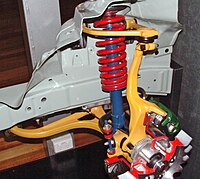Double wishbone axle
The double wishbone suspension is a form of independent suspension on automobiles on both the front and rear axles . It is characterized by two wishbones and a handlebar .
This design emerged from the independent wheel suspension with two transversely arranged leaf springs . To make the wheel suspension more rigid against longitudinal forces, two wishbones were installed in the same place and the function of the vehicle suspension was relocated to separate springs ( coil springs , torsion bar springs ). An interim solution was to replace just one leaf spring. The track angle change when springs are controlled by the tie rod. In racing cars there is a design in which the lower wishbone is installed in reverse (two articulation points on the wheel carrier, one articulation point on the body). The rod guide is then oriented in the longitudinal direction to support the driving forces.
By changing the link lengths and the position of the bearing points, the suspension can be good relatively vote . The upper link is shorter than the lower, so that the track width remains almost the same during compression and the camber becomes negative, which is an advantage on the outer wheel when cornering. Brake buckling can be compensated for by twisting the wishbone axles.
This wheel control became established as a front wheel suspension from the 1930s onwards, but has been largely replaced by MacPherson axles or multi-link axles in cars since the 1970s . Often it is only used in buses, vans, sporty and racing vehicles (including the rear).
Original form: leaf springs as wishbones
yellow: wishbone and wheel carrier
blue: shock absorber
red: coil spring
literature
- Wolfgang Matschinsky: Wheel guides for road vehicles . 3rd edition, Springer, Berlin 2007, ISBN 978-3-540-71196-4 .
- Bernd Hoting, Metin Ersoy, Stefan Gies: Chassis Manual . 4th edition, Springer Vieweg Verlag. 2013, ISBN 978-3658019914 .
Individual evidence
- ↑ Wolfgang Matschinsky, p. 17
- ↑ Bernd Heißing u. a., p. 7
- ↑ Olav von Fersen: A Century of Automobile Technology. Passenger cars . VDI Verlag, 1986, ISBN 3-18-400620-4 , p. 384 .





